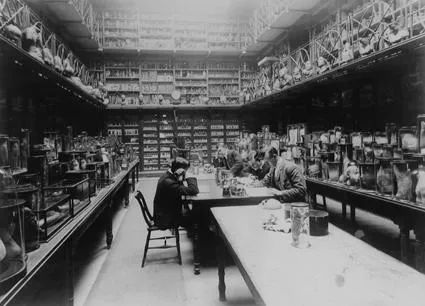
Origins of the Gordon Museum - by William G. J. Edwards, Gordon Museum Curator
There are a number of questions regularly asked by visitors to the Museum, but perhaps the most frequent one is "where have all the specimens come from?" In fact there have been formal collections of specimens and other medical ephemera on the Guy's Campus since 1826. But even these collections are predated by specimens gathered together in a much less systematic way. The earliest specimen in the Gordon Museum today actually dates from c1608. The specimens were initially brought together by Thomas Hodgkin, who became the first Medical Curator and formed the basis of the "Museum" in the first Medical School which was opened in 1826. This school was erected in the Park facing Hunt's House, roughly on the site of Nuffield House. Under Hodgkin's Curatorship the Museum became well established so that his catalogue of 1829 lists approximately 3000 exhibits. As the collection grew in size, further museums were established in the then newly built Hunt's House. By 1861, the London Journal of Medicine reported that the Museums are on a scale which entitles them to rank among the first of our national collections." These Museums not only contained a very good systematic collection of Human Pathology but also quite large collections relating to Natural History and Comparative Anatomy.
The Medical School remained on this site until, with the addition of an extra year to the student curriculum in 1890; it was proposed that the present school (now known as the Hodgkin Building) should be built. It consisted initially of the Library built with a generous donation from Henry Wills, and the Museum built solely at the cost of Robert Gordon. The Gordon Museum itself was opened in 1905. The architecture of the building is also of note, being a Victorian-style cast iron and glass construction, similar to that of Crystal Palace, divided into four sections with two storeys of galleries overlooking each quarter of the ground floor. This new Museum was intended to be a teaching resource devoted purely to human material and it is at this point that the Comparative Anatomy collections of Hodgkin's museum were removed. The Gordon Museum continued to develop new specimen collections, collect Medical and Dental instruments, equipment and ephemera until today at which point the Gordon Museum is the country's largest teaching medical museum with close to 8,000 pathological specimens on display. The museum also has some historically very significant pathology and surgical specimens, such as the original specimens of kidneys, adrenal glands, and lymph nodes which led Bright, Addison and Hodgkin to describe their eponymous diseases. The Astley Cooper surgical specimen collection can also-be seen.
Permanently on display are a number of important historic medical object collections including the Joseph Towne Anatomical, Dermatological and Pathology was model collection and the Lam Qua tumour paintings. Another prized jewel is the first stethoscope used in Britain brought over from France by Thomas Hodgkin and one of the first Lister antiseptic sprays.
The museum houses one of the college’s PAWS computer networks as well as its own PC network, it also provides teaching DVD's and videos for private study. Internally the Museum has its own lecture theatre and seminar rooms and also provides space for private study.
The Museum's primary function has always been to help train medical professionals to diagnose disease. The specimens which have been assimilated over the last 400 veers, show 'classic' and 'rare' cases of all sorts of diseases, and are arranged systematically by organ or as "topics". Each of the specimens is fully documented, and all the relevant details of the condition, medical history of the patient etc. are on show with the specimen. Recently an on-going review of these descriptions has begun with a view to update nomenclature and to gradually introduce new IT technology with which to aid use of the collections. The Gordon Museum is now one of the few left in the country that continues to accept new specimens within the strict HTA regulatory guidelines, to fill gaps in the collection and to document new and emerging diseases like HIV/AIDS. The strict HTA regulations, a consequence of Alder Hey and the Bristol scandal, prevents access to the Museum by the public but we welcome visitors from across all the Medical, Dental and Biomedical spectrums from all over the world.
Within King's College London, for many years there had been an excellent collection of Comparative Anatomy and Botanical specimens, but these collections needed a new permanent home. So in 2009 adjacent to the Gordon Museum the Museum of Life Sciences was opened, where this Life Sciences Museum can be utilised in an educational and enjoyable way just as, hopefully, the collections within the Gordon Museum are used.
The Gordon Museum has always strived to provide a service to the Medical, Dental and Biomedical Science community looking for new ways to interpret and use what has already been collected and to look forward to new horizons and new possibilities. The Museum continues to explore new technologies and techniques including extracting DNA from organs for analysis, digital scanning of specimens with a view to produce Alioscopy images and 3D Printed models. Of course who knows what technology will come along in the future, and what new information will have been extracted from these specimens in another 100 years?